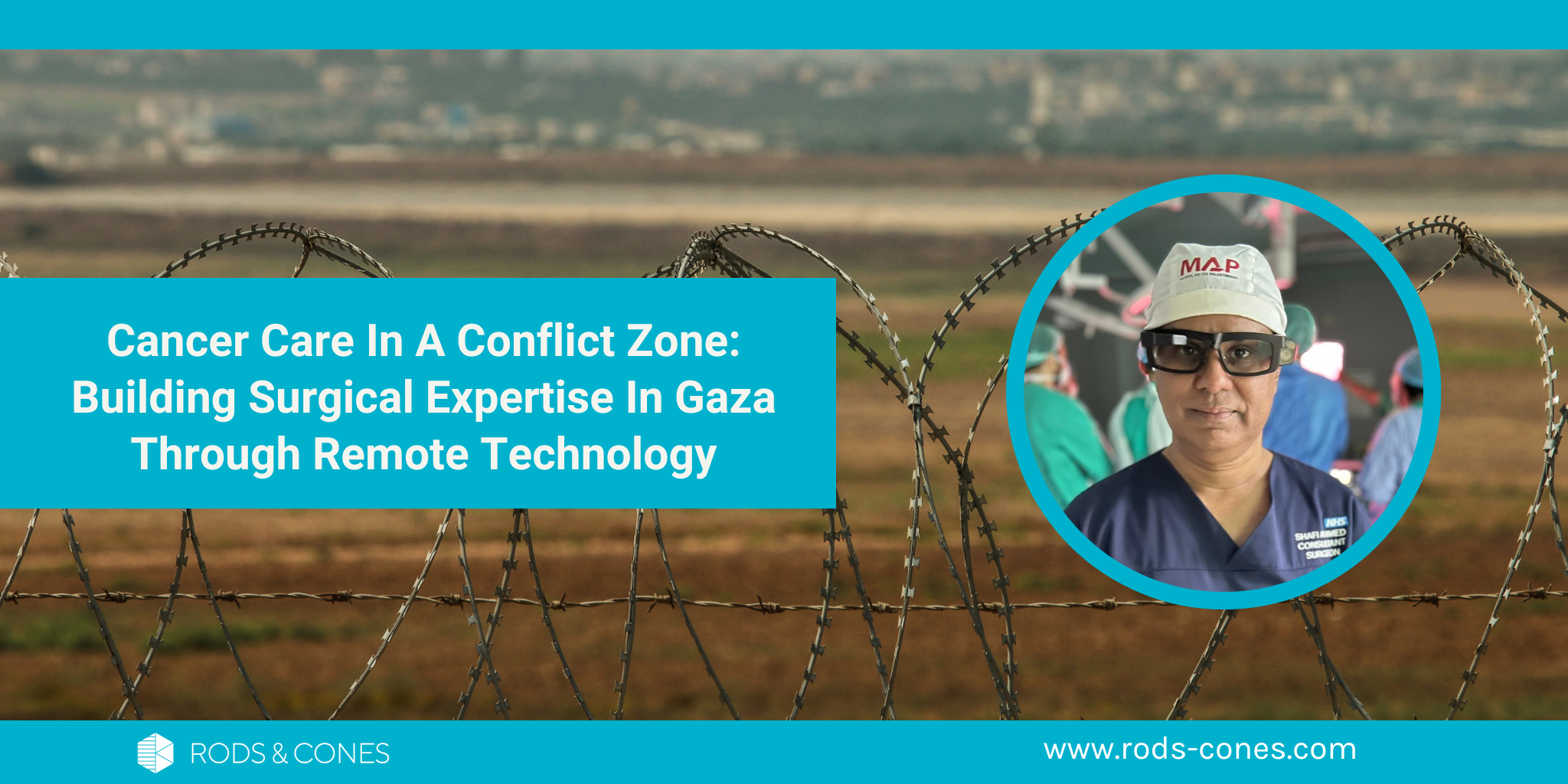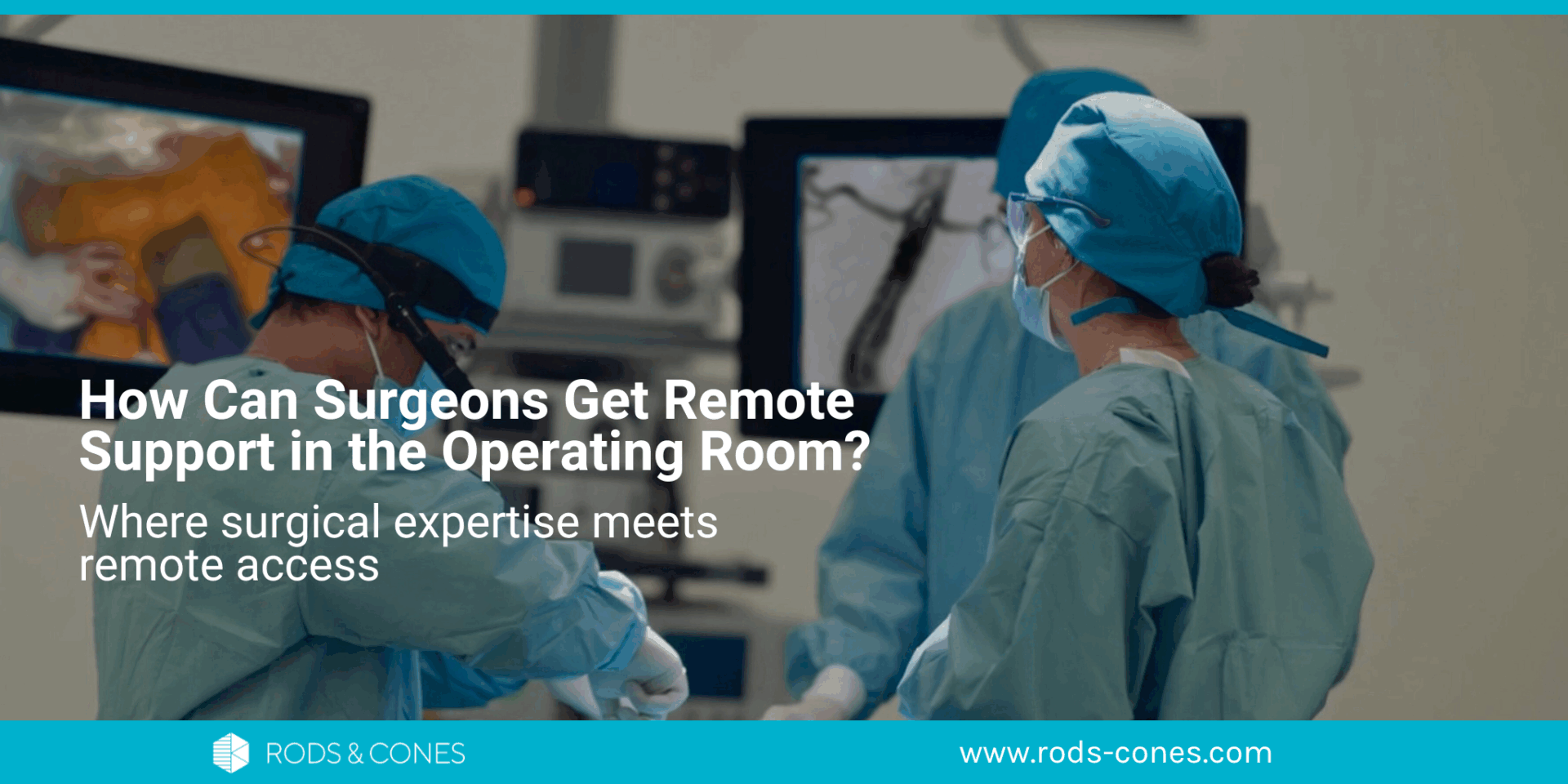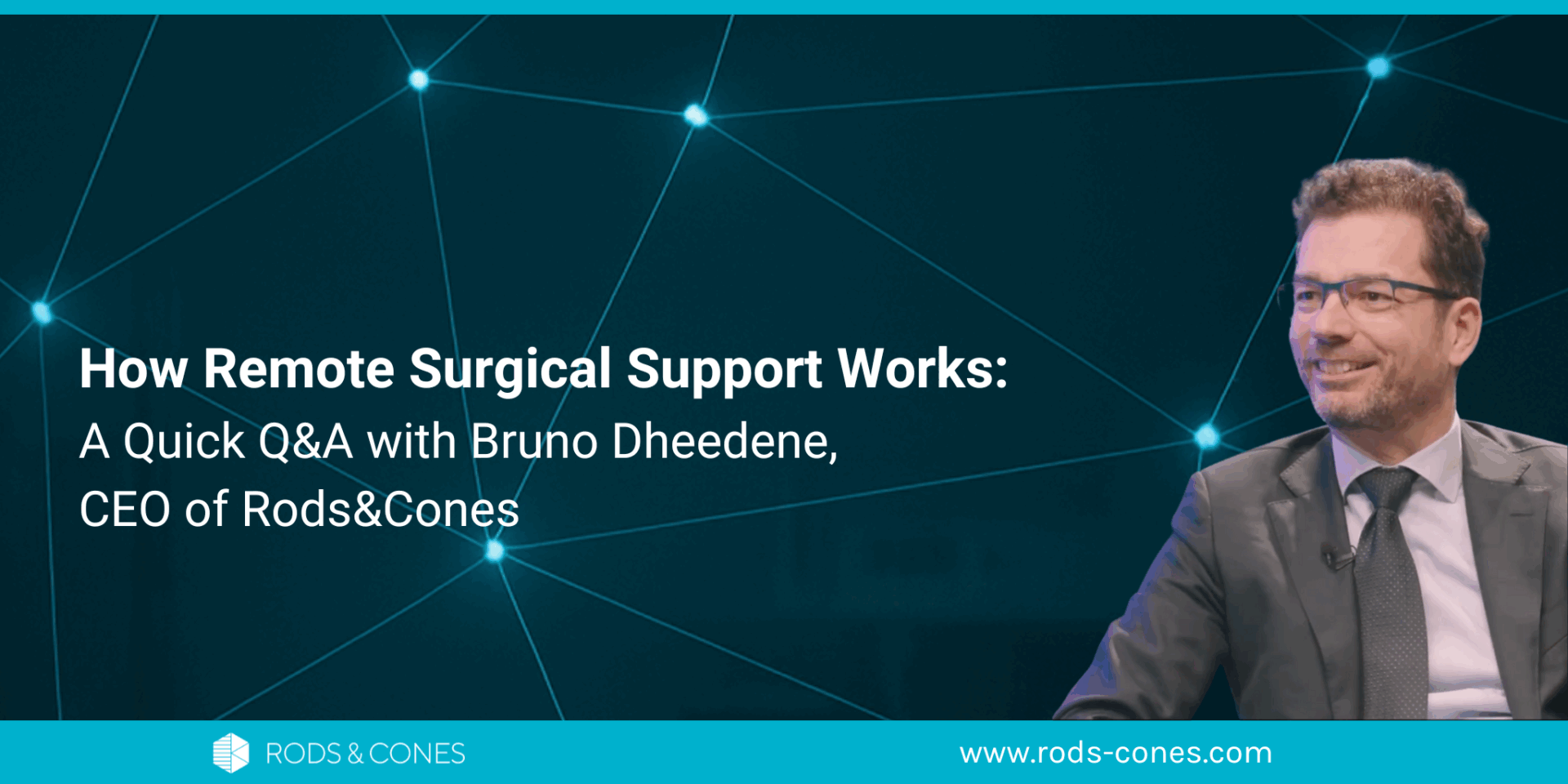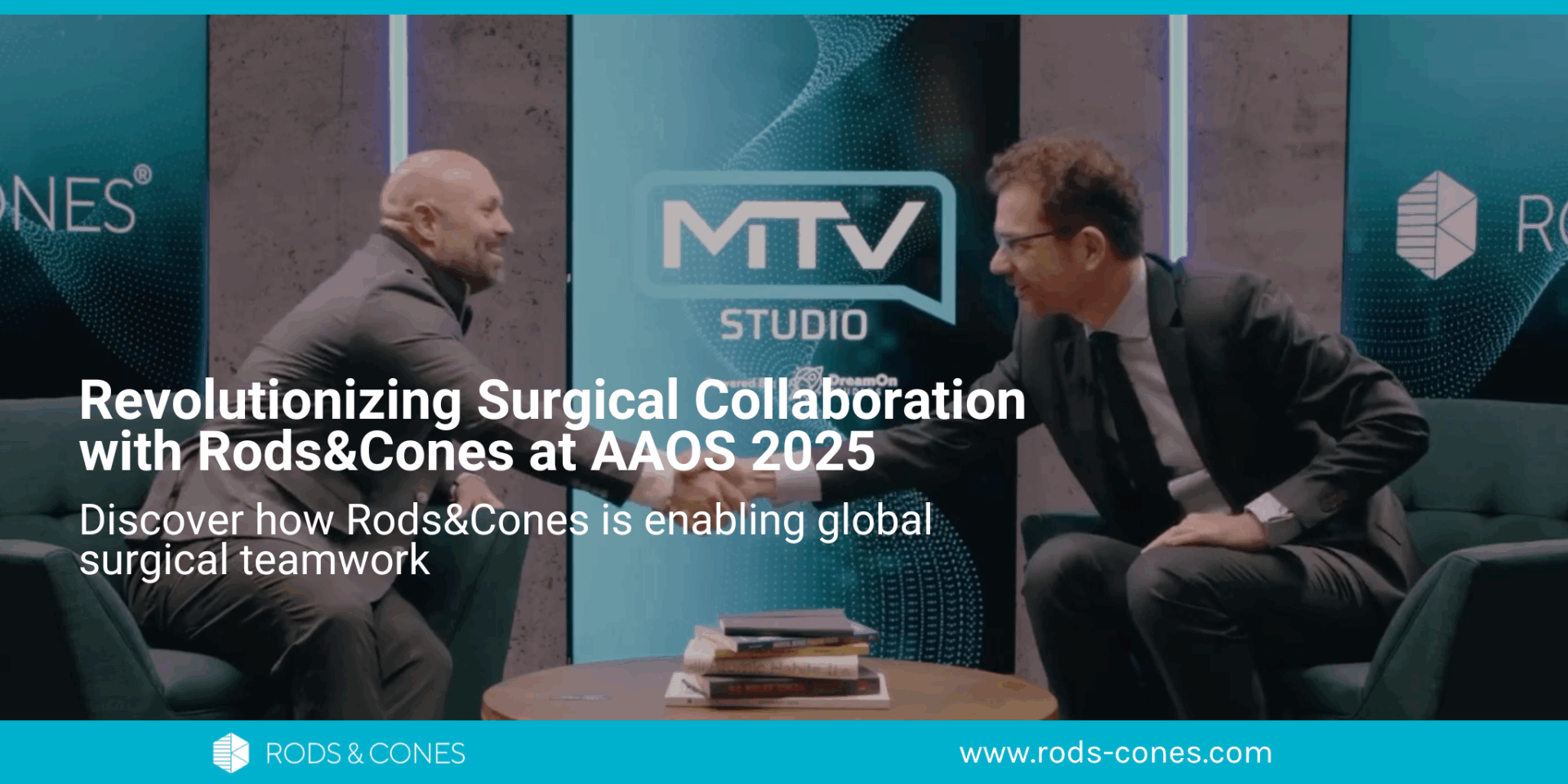When you think about the surgical care needed in a conflict zone, casualties of war are probably the first thing that comes to mind. But it’s a sad truth that conflict impacts all aspects of healthcare, including the treatment of non-communicable diseases such as cancer.
With a blockade in place for over a decade, the healthcare system in Gaza has been facing significant challenges. After the 2014 conflict, it was left in a precarious state in terms of infrastructure and healthcare provision.
So in 2015, the charity Medical Aid For Palestinians (MAP) with support from The Ministry of Health of Palestine, approached award-winning cancer surgeon and Rods&Cones ambassador, Professor Shafi Ahmed, to visit Gaza and the West Bank to provide his thoughts and recommendations for building surgical capacity.
In this blog post, Professor Shafi Ahmed explains the efforts taken to address this problem in the region and how advanced remote technology plays a crucial role in maintaining a more sustainable long-term solution. This is his story.
 Increasing Surgical Capacity Inside Gaza
Increasing Surgical Capacity Inside Gaza
“Surgical care in conflict zones and places where, for geopolitical reasons, it is hard to reach remains challenging. It forms an acid test for improving standards in remote training and care for the world as a whole.”
Professor Shafi Ahmed, Global Ambassador, Rods&Cones
One of the biggest challenges for cancer patients in Gaza is gaining access to the right treatment. With cancer, timely intervention and treatment are everything. Unfortunately, for these patients, the expertise they need often resides outside the Gaza Strip. To access it, they must apply for a visa. For various reasons, approximately two-thirds of visas are rejected by the authorities, denying many cancer patients the surgical care that they desperately need.
For this reason, it was clear from the outset that Gaza needed to increase surgical capacity and expertise. I spent a week visiting the main universities, hospitals, and medical complexes in both Gaza and the West Bank. I also met with government officials. The people I spoke with included leaders and healthcare professionals on the front line. My subsequent report made four recommendations:
- Implement more efficient and streamlined training programs led by senior surgeons.
- Enhance the surgical skills mix, particularly in the use of laparoscopic surgery.
- Modernize training for trainers to help them build better trainee relationships.
- Improve holistic cancer care by ensuring a multidisciplinary approach.
With the project agreed upon by trustees of Medical Aid for Palestinians and backed with a substantial budget, the main focus was to build a model of sustainable care. The goal was to leave a legacy within Gaza so that healthcare providers would have the surgical capacity to serve the general population, without patients needing to travel abroad.
Leaving A Lasting Legacy

One of the first things we did was to set up and run a training program for the trainers, helping senior surgeons to become the leaders of tomorrow. Alongside that, we set up two training courses. The first was designed to standardize basic skills at a junior level, so they had the right skills going forward, embedded into their curriculum. The second was to learn laparoscopic skills. This included laparoscopic simulation.
Endorsed by the Royal College Of Surgeons and the participating NGO, I led a program to introduce the courses. We took a stepped approach. We ran the first courses supported by local faculty. The local faculty ran the second course and we supported. By the 3rd course the faculty ran the course entirely themselves with quality assurance provided by the RCS By the third time around, the faculty was running the courses entirely. It was a three-way program, leaving a legacy of expertise within Gaza, and the courses are now running autonomously, three times a year, and the training is sustainable in the long term.
For the first three years, we made regular visits to Gaza. For each visit, the hospitals prepared a list of their most complex cases. We’d spend the day teaching and the evening operating. The local surgical team would perform the operations, and we’d provide guidance and teach surgical techniques.
Building Capacity For Cancer Care
“Remote assistance technology enables frontline healthcare workers to bring in the medical expertise they need, without an expert having to leave their current physical space.”
Professor Shafi Ahmed, Global Ambassador, Rods&Cones
In the second phase of the project, we focused on building capacity for colorectal cancer care. The first step was to arrange remote multidisciplinary team meetings (MDTs). This is something practiced as a standard for every cancer patient in the UK. The meetings include a radiologist, a pathologist, surgeons, nurses, and any other relevant healthcare professional to support decision-making around treatments. To deliver the best standard of care, this strategy requires teamwork, group thinking, and collective decisions on the best options for the patient.
Whilst the MDTs in Gaza were well-organized and professional, they sometimes needed help from external experts. We arranged a regular Sunday morning meeting with a team of experts from UK hospitals and the teams in Gaza. We’d go through all of their cases, look at the images, scans, and pathology, as well as understand their restrictions in terms of access to medicines. This helped to ensure the best standard of patient care, considering the available resources.
Together with a small team of specialists, I’ve made a number of week-long visits to various hospitals in Gaza to train and help perform surgery. The team varies each time, bringing different expertise into the hospitals. Alongside five days of training, we spend two or three days in the operating room. We also perform lists for trainees for surgeries such as hernias and gallbladder removal. Each of these visits ends with a symposium on the best standards of care and the latest technological advances for cancer care. Once per year, there is a remote conference on cancer, where the Ministry of Health organizes a cancer symposium.
My most recent visit to Gaza in June 2023 was my tenth operating trip which was a milestone for me and a time to reflect on the project. The team have now supported over a hundred complex surgical operations in 8 years. The first 3 phases of the project – involving 9 surgeons and 3 nurses from the UK and Italy – are now complete. Here’s some of the key data:
- 211 surgeons successfully completed the training courses.
- 11 video linked colorectal cancer MDTs.
- 6 education symposiums.
- 100+ complex cancer and general surgery operations performed.
- $500 000 of Laparoscopic equipment donated.
Using this and other data, we’re now evaluating the impact we’ve had, reflecting on what we’ve done, and what needs to happen next. It has to be said that of all the projects that I have been involved with during my 30-year career as a surgeon, this has been the most important and rewarding one. I’m looking forward to completing Phase 4 by 2025.
Embracing Remote Connectivity
“In terms of visualization, the lighting, and the platform for connecting people and moderating surgical sessions – Rods&Cones is the answer to all the problems that I had before.”
Professor Shafi Ahmed, Global Ambassador, Rods&Cones
Back in 2016, I performed the world’s first virtual reality (VR) surgery. This helped to set the stage and laid the groundwork for the possibilities of remote training. The work we did back then, really helped to support what happened during COVID-19, and the work that’s happening now, both in Gaza and other areas of the world.
Remote connectivity has an important part to play in training. When I think back to my time as Dean of Bart’s Medical School, one of the challenges we came up against was when we had seven or eight students in a surgical theatre. The training wasn’t particularly efficient because many of the students couldn’t take part, and missed out on key knowledge over eight hours in surgery. In some circumstances, this traditional training model almost expects students to learn via osmosis, rather than through active learning. Remote connectivity can help to disrupt that outdated model and provide medical students with higher quality and, ultimately, higher value education.
More than ten years ago, when remote technology became more accessible and more viable, I could see the potential for education. My first live surgery was transmitted to over 14,000 people across the globe in around 180 countries. The next time, that rose to over 50,000 people in 4,000 cities, who connected to watch a live operation. These examples showed the potential of using high-tech but low-cost technology to democratize education. Fast-forward to 2022, Rods&Cones has taken the bull by the horns and created a solution for the problems I was facing when using rudimentary technology in 2014.
Rods&Cones has thought about the inherent challenges. Smart surgical glasses are just one aspect of their solution. They’ve considered the entire surgical environment and the wider ecosystem of training and learning – and how we solve those education problems. It’s clear that they’ve thought about whether the technology makes sense, what the interface looks like, and the experience it provides trainee surgeons.
Rods&Cones In Gaza
 In July 2022, I took two Rods&Cones kits to Gaza. The kits went to two different hospitals, where we performed a number of live operations. The remote assistance technology was well received and during my most recent visit in 2023, I learned more about the impact it’s making.
In July 2022, I took two Rods&Cones kits to Gaza. The kits went to two different hospitals, where we performed a number of live operations. The remote assistance technology was well received and during my most recent visit in 2023, I learned more about the impact it’s making.
The key to any new technology’s long-term success is stickiness. In this case, that requires regular usage, as well as obvious benefits for frontline healthcare staff, and their connectivity to a wider medical community. It also takes a team to successfully embed remote assistance technology securely and ethically into surgical practice to realize the advantages it brings.
Having a single champion of new technology is great, but with a dedicated team of people, it’s possible to leverage the real benefits for better surgical care, and improve outcomes for patients in a conflict zone, or anywhere else in the world.
Rod&Cones is a remote assistance solution for medical environments. Find out more about the technology that’s helping to democratize surgical care around the world. Book a demo.
Read more about this and other topics regarding surgery both in Gaza and in other fields here.





